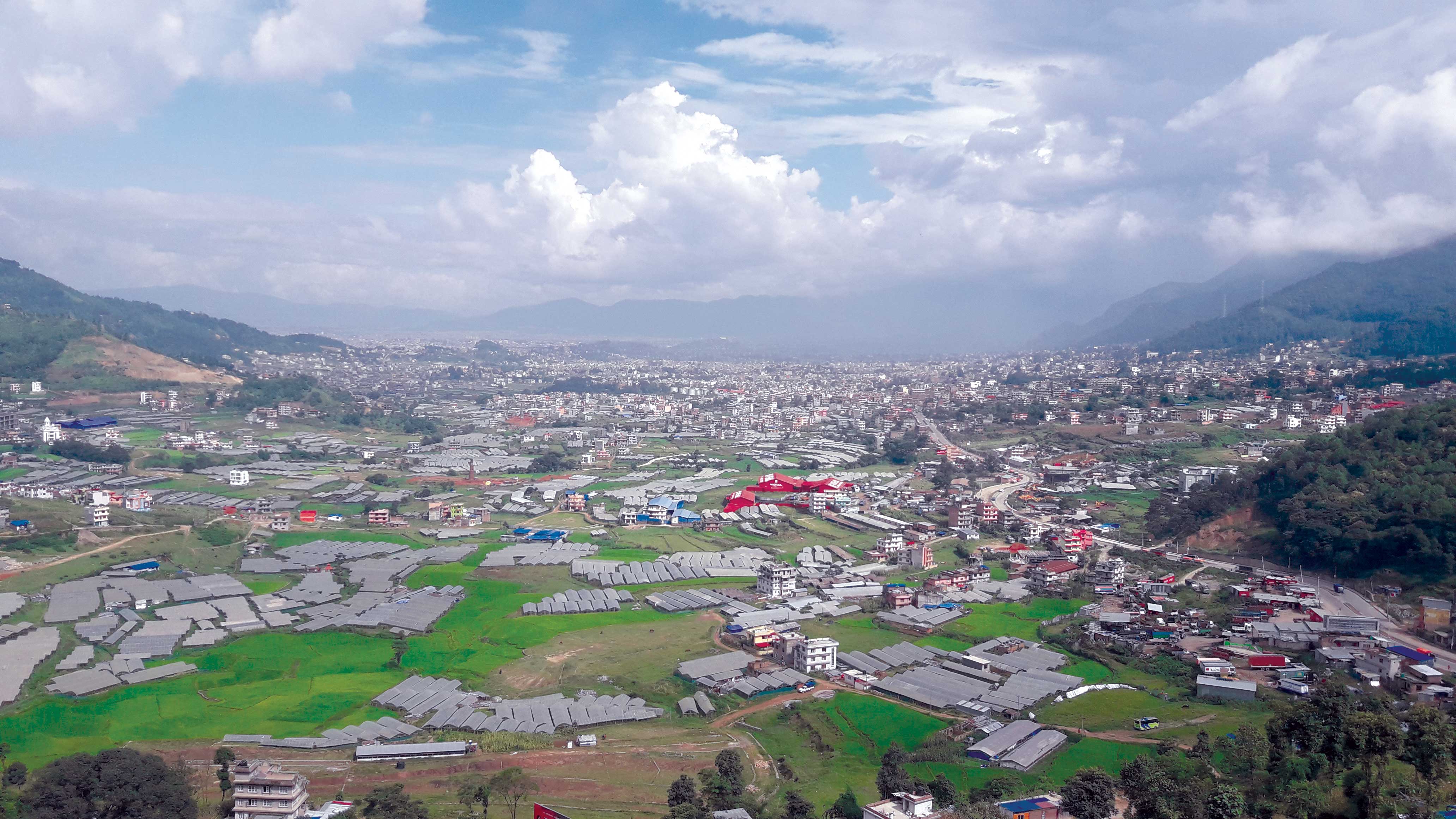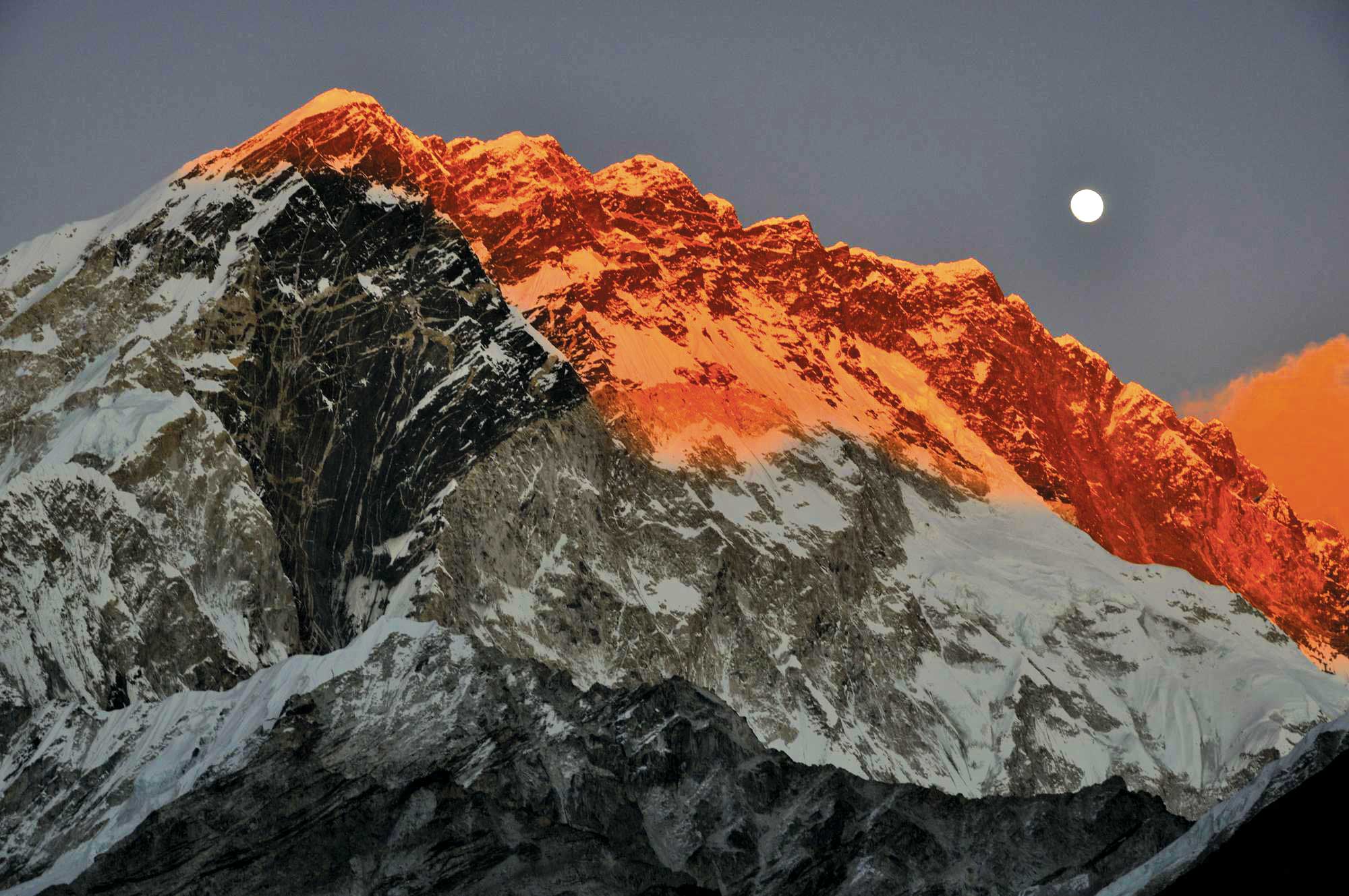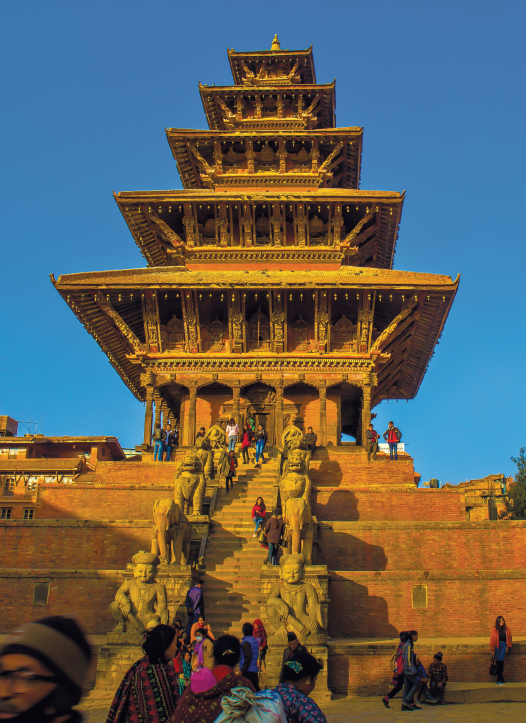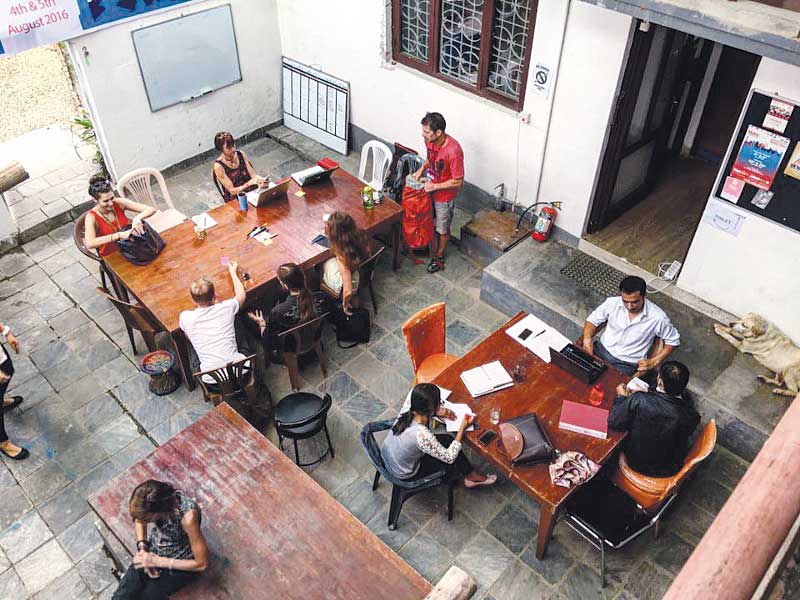The athlete was in superb physical condition. His wheatish hair springing up with every stride he took. His fair face set in grim determination looked inward to the very core of his being. Just under six feet in height, he simply flew over the trail while we laboriously plodded along. I was impressed.
 Soon other runners started over taking us; their breathing was ef fortless, strides sure and confident. I and my good friend, Dr Praveen Partha, were in the Annapurnas trekking to Tilicho lake (around 4,900 m at the foot of Tilicho Peak) when a race with the catchy title of ‘ABC to EBC’ (Annapurna Base Camp to Everest Base Camp) was underway. The racers were running to Tilicho Lake from Manang village and then returning to the village for the night.
Soon other runners started over taking us; their breathing was ef fortless, strides sure and confident. I and my good friend, Dr Praveen Partha, were in the Annapurnas trekking to Tilicho lake (around 4,900 m at the foot of Tilicho Peak) when a race with the catchy title of ‘ABC to EBC’ (Annapurna Base Camp to Everest Base Camp) was underway. The racers were running to Tilicho Lake from Manang village and then returning to the village for the night.
I have always been fascinated by long distance athletic events, specially the marathon. In modern Olympics the marathon is usually the last event, often held just before the closing ceremony. The image of the lead runner entering the stadium, completing his victory lap with his country’s flag and being escorted by his coach and support team members to his bench has always stirred deep emotions within me.
The marathon is a long-distance foot race with an official distance of 42.195 km (26 miles 385 yards, or exactly 26.22 miles). The origin of the event dates to a time when the ancient Greeks were fighting with the Persians in a place called Marathon. The date of the battle has been estimated to be 490 BCE (Before Common Era). A messenger named Pheidippides ran nonstop from Marathon to Athens and burst into the assembly, exclaiming “Nenikékamen!” (‘We have won!’) before he collapsed and died. Certain historians, however, are skeptical about this classical story. The distance he ran was approximately 42 km (26 miles), which accounts for the length of the modern marathon. Marathon was included in the first modern Olympic Games in Athens in 1896. The race was won by Spiridon ‘Spiros’ Louis, a Greek water-carrier. The Olympic men’s record is 2:06:32, set during the 2008 Summer Olympics by Samuel Kamau Wanjiru of Kenya.
Everest marathons
Today a number of marathons are held all over the world, and even a Lhasa marathon is planned to be held in 2010. Three marathons are held with the magic word ‘Everest’ in their title. The ‘Mount Everest Challenge Marathon’ is held in Darjeeling, India, in November. And two are held in Nepal’s Khumbu region, the ‘Tenzing Hillary Everest Marathon’ in May and the ‘Everest Marathon’ in November-December. The Everest marathon is held every alternate year and starts from Gorak Shep while the Tenzing Hillary Marathon starts from Everest Base Camp (EBC). The Tenzing Hillary Marathon commemorates the first ascent of Mount Everest by Sherpa Tenzing and Sir Edmund Hillary on May 29, 1953. The Tenzing Hillary Marathon is the world’s highest marathon; starting at around 5,360 m it is higher than the highest peaks on many continents.
The ‘Everest Marathon’ was started in 1985 by Jan Turner and Tony Hunt who were trekking to Everest Base Camp. Jan Turner pioneered the course in 12 hours without aid stations and carrying a full back pack. On their return to Namche Bazaar they also set up an impromptu half marathon. On his return to the United Kingdom, Jan Turner advertised for competitors and got a trekking agent (Bufo Ventures) to organize logistics. The first organized event was held in 1987. The profits from the race go to the ‘Everest Marathon Fund’, which supports health and educational projects in rural Nepal. The Everest Marathon has been held 12 times and applications for the 13th marathon in November-December 2009 are now being invited. The Tenzing Hillary Everest Marathon was first held in 2003. This marathon traces in reverse the historic approach route of Tenzing and Hillary to the foot of Mount Everest in 1953.
The seventh edition of the Tenzing Hillary Marathon was held recently on May 29. The weather was inclement and the pre-monsoon rains dumped snow on the track. There was over four foot of snow at EBC, the starting point and there were doubts whether the race would take place. A total of 105 athletes including 52 foreigners competed. The race was won by Phurba (also spelled Furwa) Tamang of Nepal in 3 hours, 40 minutes and 46 seconds. Phurba is from Lukla, the main airport for the Everest (Khumbu) region. Tamang’s elder brother, Raj Kumar, finished second. Athletes from the Indian Army dominated the foreigners’ category. Mingma Chemji Sherpa won the women’s category, completing the race in 5:05:31. The three times champion, Deepak Rai, did not participate this year due to injury. Nepalese runners have consistently outperformed foreigners. Last year’s winner in the foreigner’s category acknowledged the native superiority when he said, “We cannot beat Nepalis as they know exactly where to put their feet on the stones in the glaciers till Gorakshep. They fly on the stones.”
Marathons and mountain medicine
The Mountain Medicine Society of Nepal (MMSN, www.mmsn.org.np) is a group of doctors and medical students keenly interested in the mountains and mountain medicine. MMSN conducts research on various illnesses associated with altitude and volunteer doctors occasionally staff the two trekker’s aid posts run by the Himalayan Rescue Association (HRA) in Pheriche and Manang. MMSN also provides volunteer doctors for the Everest marathons. My good friend, Kshitiz Alekh volunteered recently.
The logistics of the race are difficult. With the proliferation of flights and tourists to the Khumbu we do not realize the remoteness of the region! Namche is a two day trek from Lukla airport while EBC is at least five days with acclimatization stops. Namche is over a week’s trek from the road head at Jiri.
The run starts from the scenic environs of EBC at the foot of the world’s highest mountain. The unearthly landscape of rocks, peaks, glaciers and snow makes one uneasy. The initial route is on the Khumbu glacier. Finding the trail along the debris can be difficult and you have to depend on the cairns and stones serving as markers. The route is slippery and especially difficult if there is snow. You are blessed with spectacular views of the highest mountains on Earth. Nuptse and Pumori dominate the views on the two sides. The serac formations along the glacier are fascinating. The lake just before Gorak Shep, the site of the Swiss Base camp, comes into view and you continue to the lodges. To your right the black rock of Kala Pathar, the famous Everest view point, rises steeply from the glacial moraine. The run is along the Khumbu glacier (for the most part) to the small hamlet of Lobuche at around 4,900 m. After Lobuche the runners descend the terminal moraine of the Khumbu glacier and reach the lodges of Dughla. The mountain panorama is spectacular and you see Ama Dablam from an unusual perspective. From Dughla the route continues to the spread out village of Dingboche. Dingboche gets more afternoon sunshine, is less windy than Pheriche, and many trekkers prefer to stay there. It has good views of Lhotse and Island Peak in addition to Ama Dablam and other ranges.
You continue to the large Sherpa village of Pangboche crossing the pastures of Orsho on the way. Pangboche is said to be the first village settled by the Sherpas when they migrated to Khumbu from Tibet several hundred years ago. The views of Ama Dablam from there are spectacular. From Pangboche the rocky trail descends to the forests of Deboche, a peaceful place with a nunnery.
The descent to Deboche is tricky if there is snow and I still remember my adventure of 2006. There was heavy snow fall the previous night and I was hiking down to Namche. The trail slopes outwards just before Deboche and the descent was tricky. My feet were heading towards the river valley far below.
The climb up to Tengboche Monastery is short but steep. The mountain views are spectacular, with Everest, the Lhotse-Nuptse wall, Kangtega, Tawachee, Tamserkhu and other Himalayan giants.
The descent to Phunki Tenga (the lowest point in the Khumbu valley) is steep and runners continue to Sanasa. The route then passes through the quieter, less commercialized villages of Khumjung and Khunde to the view point of Syangboche with its rarely used airstrip and the luxurious Everest View Hotel. From Syangboche you descend steeply to the bustling Sherpa capital of Namche Bazaar.
The ‘Everest Marathon’ follows a different route in places. It starts from Gorak Shep and takes the lower valley route through Pheriche. The route does not go through Khumjung and Khunde but diverts to Thamo from Chorkhung. Namche, at around 3,400 m., is a dynamic place with shops, restaurants, bakeries and even cyber cafes. The organizers provide aid posts and water points for the runners at various places along the way.
Marathon facts
The marathon accepts three categories of participants – full marathoners, half marathoners and non-runners. The marathon registration fees for foreigners are US$2,085 US dollars for a participant and US$1,885 for a non-runner. Participants (runners) must be physically fit and mentally sound. A medical certificate from a doctor is necessary. Non-runners should be in good health and physically fit and all non-runners must have previous hiking experience on varied mountainous terrain. Details of the signing up procedure and other information can be had on the event website, www.everestmarathon.com. Details about the marathon to be held in November-December can be seen at www.everestmarathon.org.uk.
The participants of the May event arrive in Kathmandu on May 14, spend a day sightseeing in the valley on the 15th and fly to Lukla on the 16th. They slowly trek up the Khumbu valley with rest and acclimatization stops and reach the base camp on the 27th. After a rest day the race commences on the May 19th at 7 am. The half marathon runners trek to Orsho from Gorak Shep on the morning of the 28th and start from there at 7 am. The non-runners trek down to Namche from Gorak Shep reaching the town on the 28th ready to receive the runners the next day.
Running a marathon leads to a number of changes in the human body. The body’s preferred energy sources are glycogen and sugars. These are soon depleted, however, and the body burns other fuels like fat. There is an accumulation of lactic acid and other acids, the runner experiences dramatic fatigue and is said to ‘hit the wall’. Depletion of glycogen stores occurs at around 20 miles. The amount of stored muscle glycogen can be increased before the race through dietary changes (referred to as ‘glycogen loading’).
There is also a loss of water from the body causing dehydration. If the water loss is replaced by drinks poor in electrolytes there is a high risk of hyponatremia (low blood sodium level).
The body regards the ‘marathon’ as a stress and increases the levels of the stress hormones, epinephrine, norepinephrine and cortisol. Changes in body salts can cause muscle cramps. There is a diversion of blood supply to the leg muscles starving the intestines. This relative ‘ischemia’ has been postulated to be responsible for gut problems.
The Everest Marathon is run on very rough terrain and carries a high risk of sprains, falls and other injuries. Altitude problems while trekking up to and at the base camp should also be kept in mind. If running on snow on a bright day snow blindness can occur. The weather can change rapidly and the runner can be exposed to extremes of heat and cold on the same day. Stomach problems and infections can be reduced by consuming boiled water and properly cooked food.
Most trekkers take two long days (some even three) to descend to Namche from Gorak Shep. EBC is a three to four day trek from Gorak Shep along the rough Khumbu glacier. To compress 16 to 20 hours of walking into a four to five hours run is a great achievement. Let us salute the brave runners of the magnificent Everest marathon, the highest marathon on Earth!
Amelia Hillary, the 18-year old granddaughter of Sir Edmund Hillary, was recently appointed as the brand ambassador of the Everest Marathon event, organized by Himalaya Expeditions of Sanepa, Lalitpur, in association with other sponsors and agencies. “I am very pleased to be associated with this event. I will continue promoting this marathon,” the 18-year old Ms Hillary is quoted as saying (in Nepaltravelnews.com). “Nepal is like my second home and I will always be close to this event.” Amelia Hillary is the daughter of Sir Edmund’s son Peter, who has also summited Mount Everest. The Hillary involvement is bound to give the Everest Marathon greater exposure worldwide.

A Cuppa to Start the Day
Having a cup of tea in the early morning is almost a ritual for many Nepali homes and the practice...










